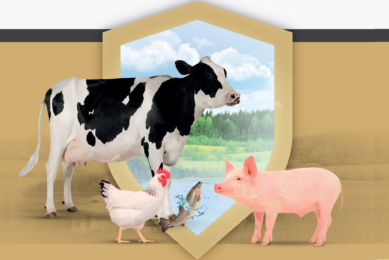Don’t let mycotoxins affect milk quality

Feeding mycotoxins contaminated rations can lead to the appearance of mycotoxins in milk. But the rate of carry-over from feed to milk can vary. Nevertheless, contaminants in the feed should be prevented to keep the milk quality at the desired level.
Many factors on farms are known to influence milk quality. These include;
- dairy cow breed
- season
- nutrition
- management
- hygiene
- storage
- transport
It is well established that many nutritional factors can contribute to the presence of contaminants and undesired compounds in the milk. Feeding mycotoxins contaminated rations (mainly with aflatoxin B1 [AFB1]) can lead to the appearance of mycotoxins (mainly aflatoxin M1 [AFM1]) in milk. Although AFM1 is the main mycotoxin that is transferred from feed to milk, other mycotoxins can be transferred at lower rates and may contribute to reducing the milk quality. Fumonisin B1, ochratoxin-alfa, T-2 toxin, de-epoxy-DON (DOM), and α-zearalenol can be transferred into milk when highly contaminated rations are fed. In addition, feeding mycotoxin contaminated rations may reduce fat and protein content, and increase somatic cell counts and bacterial load in milk; all of which contribute to significantly reducing the milk quality.

Aflatoxin M1 in milk
The mycotoxin of greatest concern for milk quality is aflatoxin M1 (AFM1), which is derived from AFB1 found in feed. AFM1 is believed to be a carcinogen and hence needs to be controlled in milk especially when it is used for infant and child nutrition, as well as for the elderly.
Carry-over rate
Many studies, reviews and data analyses showed that about 1 to 2% of the ingested AFB1 is carried over and transformed into AFM1 in milk. The extent of transfer from feed to milk (carry-over) is influenced by various nutritional and physiological factors, and by the health of the animal, including udder health.
In high-yielding cows, the carry-over rate was found to be 6.5%. From carry-over data, it is possible to calculate the upper limit of contamination in the ration to keep the AFM1 level in milk below a certain limit.

Mycotoxin Regulations Tool – interactive tool for regulations per country
The safe limit of 2% carry-over not being achieved
A recent study conducted in the USA strongly suggested that the current “safe” limits of aflatoxin established on a carry-over of 2% allowed in feed for dairy cows do not protect against violating the current regulations for AFM1 residue in the resulting milk. This study showed that the carry-over percentage in modern high producing dairy cows is 6.5%, which is significantly higher than the 1 to 2% that has been suggested by previous studies (EFSA, 2004). A recent survey on 38 farms in upstate New York, USA, indicated that over 14% of the milk samples collected violated EU regulations for AFM1 (0.050 μg/kg) (Churchill et al., 2016). In surveys performed in the Southern and Midwestern States, USA, 4% to 40% of raw milk samples contained AFM1 in a concentration higher than 0.050 μg/kg (EU limit), whereas 0.1% to 18% samples contained AFM1 in a concentration higher than the maximum level in the USA (0.50 μg/kg) (JECFA, 2001). Surveys conducted in Asia (Indonesia, Thailand and the Philippines) indicated that about 80% of the milk samples contained AFM1 in a concentration higher than 0.050 μg/kg and about 20% samples contained a concentration higher than 0.50 μg/kg (JECFA, 2001).
Other mycotoxins in milk
In addition to aflatoxins (from Aspergillus mould); deoxynivalenol (DON), zearalenone (ZEN), T-2 toxin, and fumonisin (from Fusarium moulds); and ochratoxin and PR toxin (from Penicillium moulds) and ergots are known to affect cattle and at times may be prevalent in certain feedstuffs. Because ruminants consume forages, by-products, and wet feeds, in addition to raw materials and compound feed, they are exposed to a broader range of mycotoxins challenges. Despite this wide range exposure to mycotoxins by ruminants, studies addressing the transfer of mycotoxins other than AFM1 into milk are very limited. These limited studies showed that a few other mycotoxins such as fumonisin B1, ochratoxin-alfa, T-2 toxin, DOM, and α-zearalenol can be transferred in milk. However, the transfer rate was very low and rarely exceeded 0.1 %, except for T-2 toxins where a transfer rate ranging from 0.05 to 2 % was reported. A recent study determined the carry-over rates of Roquefortin C and Mycophenolic acid to milk by adding high doses of the purified mycotoxin to the diet, and found them to be negligible (0.002-0.004% and 0.003-0.005%, respectively) (Driehuis and Wells-Bennik, 2011).
Effect on milk components and SCC
Evidence exists that prolonged consumption of mycotoxin contaminated diet by dairy cows can:
- reduce feed consumption
- reduce milk yield
- result in chronic immune suppression
- possibly reduced reproductive performance.
Mycotoxins can alter microbial growth and fermentation in the rumen, reducing fibre digestion, volatile fatty acids (VFA) production and microbial protein synthesis, which reduces the flow of utilisable protein to the duodenum. Mycotoxins can also reduce nutrient absorption, affect liver function, impair metabolism and alter endocrine and exocrine systems. This in turn reduces the availability of nutrients to the mammary gland and can lead to a reduction in milk components such as milk fat and protein and possibly minerals and vitamins. Some studies reported that feeding DON and ZEN contaminated rations to dairy cows reduced milk fat % significantly (Charmley et al., 1993). However, the effect on milk protein % is less established and inconsistent, and there is a lack of studies concerning the effect of mycotoxins on milk mineral and vitamin content. Mycotoxins are also known to suppress immunity, irritate tissues, and cause cellular death in the mammary gland. Many studies reported reduced white blood cell and neutrophil counts and reduced serum immunoglobulins and complement proteins when ruminants received diets contaminated with T-2 toxin (Gallo et al., 2015). It was hypothesised that the primary basis of T-2 toxin reduced immunity is reduced protein synthesis limiting the production of important inflammatory mediators. Cows with reduced immunity are more susceptible to infection and disease including mammary infection. This in turn can increase the incidence of sub-clinical mastitis and increase somatic cell count (SCC) and bacterial load in the milk. Some studies in the literature reported increased SCC and incidence of new intra-mammary infection when cattle were fed mycotoxin contaminated rations. Increased SCC is one of the primary quality concerns in the dairy industry.

Find out the mycotoxin prevalence levels per year and region in the new tool on All About Feed, created in cooperation with Biomin.
Keep milk quality high
Management of all aspects of crop production, transport and storage can reduce but not totally prevent the occurrence of mycotoxins in dairy cow feed. Good agricultural practices, antifungal agents, genetic engineering (hybrid selection) and storage control can help reduce contamination. This should be complemented using certain mycotoxin deactivators* for example, that can help reduce the toxin interactions with the consuming animal and prevent mycotoxin absorption across the digestive tract. The efficacy of such deactivators was recently evaluated in a University study where total mixed ration (TMR) contaminated with AFB1 was fed to dairy cows either with or without the products. A reduction of appearance of AFM1 in milk was seen of 50 and 63%. Milk fat percentage was also significantly increased, leading to higher fat corrected in milk production.
Mycotoxin management is key
Controlling mycotoxins in dairy farming is essential to achieve the maximum genetic potential from the animals and is an integral part of strategies that aim to produce high quality milk for human consumption. Therefore, mycotoxin management is key in managing the peak performance of the dairy business.
*Nutriad’s Mycotoxin Management product range. References are available on request.
Join 13,000+ subscribers
Subscribe to our newsletter to stay updated about all the need-to-know content in the dairy sector, two times a week.











